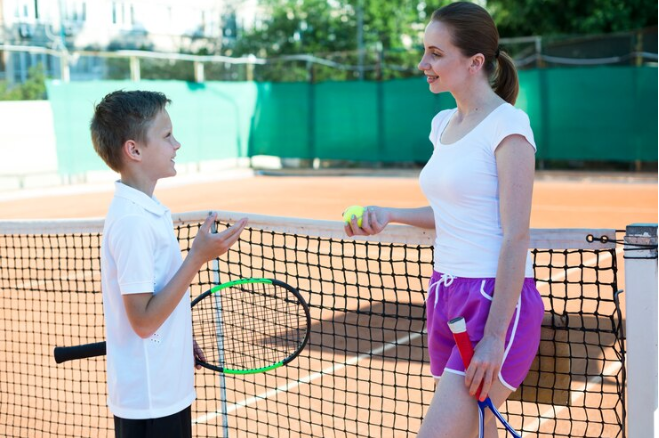What are the Official Pickleball Rules for Beginners:A Complete Guide

Pickleball, a unique blend of tennis, badminton, and ping-pong, has taken the world by storm. This exciting sport has captured the hearts of players of all ages and skill levels, offering a fun and engaging way to stay active. As a beginner, understanding the official pickleball rules is crucial to fully embracing the game's essence and enjoying it to the fullest.
In this comprehensive guide, I will break down the essential pickleball rules, equipment, scoring system, and court positioning. Whether you're a seasoned athlete or a newcomer to the world of racket sports, this article will provide you with the knowledge and insights you need to confidently step onto the pickleball court and showcase your skills.
Essential Equipment for Pickleball
Before we dive into the intricate details of pickleball rules, let's familiarize ourselves with the necessary equipment:
Pickleball Paddle: Composed of a composite material or wood, the paddle is the primary tool used to strike the ball. Its unique shape and perforated surface provide exceptional control and spin.
Pickleball: This specialized ball, similar in size to a wiffle ball, features a unique combination of holes and a lightweight, plastic construction, allowing for a slower and more controlled flight path.
Pickleball Court: A pickleball court is roughly one-quarter the size of a tennis court, with a net dividing it into two equal halves. The court dimensions are specifically designed to accommodate the game's unique dynamics.
Appropriate Attire: Comfortable and breathable clothing, along with non-marking shoes, ensure optimal performance and safety on the court.
Basic Rules of Pickleball
Now that we've covered the essential equipment, let's delve into the fundamental rules that govern this exciting game:
Serving: The game begins with a serve, which must be underhand and struck diagonally into the opponent's service court. The server must keep both feet behind the baseline during the serve.
Double-Bounce Rule: After the serve, the ball must bounce once on each side of the court before players can volley it back and forth. This rule applies only to the first return of serve.
Non-Volley Zone: Also known as the "kitchen," this area extends 7 feet from the net on both sides. Players are not allowed to volley the ball while standing within this zone; they must let the ball bounce before returning it.
Faults and Replays: If a player commits a fault, such as hitting the ball out of bounds or violating the non-volley zone rule, the opposing team scores a point. If a fault occurs during the serve, it results in a replay, and the server gets another chance.
Serving Rules in Pickleball
Serving is a crucial aspect of pickleball, and mastering the serving rules is essential for success. Here are the key points to remember:
Service Sequence: The serving team serves first, and the service alternates between teams after each point is scored. Within a team, players alternate serving every two points.
Serving Positions: The server must stand behind the baseline, and the receiver must stand diagonally across the court. Both players must remain in their respective service areas until the ball is struck.
Serving Faults: A serve is considered a fault if it lands outside the receiving court, touches any permanent object before bouncing in the correct service court, or if the server's feet touch or cross the baseline before striking the ball.
Let Serves: If a serve hits the net but lands in the correct service court, it is considered a "let serve," and play continues without replaying the serve.
Scoring System in Pickleball
Pickleball's scoring system is straightforward yet unique. Understanding it is crucial for keeping track of the game's progress and determining the winner:
Scoring Points: Only the serving team can score points. If the receiving team wins the rally, they gain the right to serve, but no points are awarded.
Game Scoring: A game is typically played to 11 points, and a team must win by a margin of 2 clear points.
Match Scoring: A match consists of the best of 3 or 5 games, depending on the tournament or agreed-upon format.
Scoring Terminology: Players often use terms like "0-0-2" or "4-3-1" to indicate the score. The first number represents the serving team's score, the second number represents the receiving team's score, and the third number indicates the server's position within the team (1 or 2).
Faults and Penalties in Pickleball
To maintain the integrity and fairness of the game, pickleball has a set of faults and penalties that players must be aware of:
Faults: Faults occur when a player violates a rule, such as hitting the ball out of bounds, stepping into the non-volley zone before the ball bounces, or touching the net with their paddle or body.
Penalties: Penalties are imposed for more severe infractions, such as unsportsmanlike conduct or intentionally disrupting the game. Penalties can range from a warning to disqualification, depending on the severity of the offense.
Line Calls: Players are responsible for making line calls on their side of the court. If a player disagrees with a line call, they can respectfully request a replay or consult with their partner or opponents to resolve the issue.
Officiating: In some tournaments or high-level competitions, official referees may be present to enforce the rules and make line calls.
Court Positioning and Rotations
Proper court positioning and rotations are essential for effective team communication and strategy in pickleball. Here's what you need to know:
Doubles Positioning: In doubles play, partners typically position themselves diagonally across from each other, with one player at the non-volley line and the other near the baseline.
Rotations: After each point, players rotate positions to maintain a balanced court coverage. The player who served the previous point moves to the opposite side of the court, while their partner moves to the position they vacated.
Communication: Clear and effective communication between partners is crucial for successful court positioning and rotations. Calling out positions, covering open spaces, and supporting each other's shots are essential strategies for doubles play.
Singles Positioning: In singles play, court positioning is more flexible, as players can move freely around the court to cover shots and adjust their strategy based on their opponent's strengths and weaknesses.
Common Pickleball Terms Every Beginner Should Know
To fully immerse yourself in the pickleball community and communicate effectively with fellow players, it's essential to understand the common terminology used in the sport:
Dink Shot: A soft, low shot aimed to land just over the non-volley line, often used to reset the rally or catch the opponent off guard.
Volley: Hitting the ball before it bounces, typically performed near the non-volley line.
Lob: A high, arcing shot aimed to force the opponent back from the non-volley line.
Drive: A powerful, low-bouncing shot hit with topspin, often used as an offensive shot.
Poach: When a player moves from their assigned position to intercept and return a shot intended for their partner.
Handedness: Refers to whether a player is right-handed or left-handed, which can impact court positioning and shot selection.
Kitchen: Another term for the non-volley zone, the area extending 7 feet from the net on both sides.
Tips for Beginners to Master Pickleball Rules
As a beginner, mastering the pickleball rules can seem daunting, but with the right approach and mindset, you'll be well on your way to becoming a skilled player. Here are some tips to help you along the way:
Start Slow: Don't try to learn and implement all the rules at once. Focus on mastering the basics first, such as the serve, double-bounce rule, and non-volley zone. As you gain confidence, gradually incorporate more advanced techniques and strategies.
Practice, Practice, Practice: The more you play, the more comfortable you'll become with the rules and the flow of the game. Attend beginner clinics, join a local pickleball club, or organize friendly matches with friends to get as much court time as possible.
Watch and Learn: Observing experienced players can be an invaluable learning experience. Pay attention to their court positioning, shot selection, and how they apply the rules in different situations. Don't be afraid to ask questions and seek advice from more seasoned players.
Stay Positive and Have Fun: Pickleball is a game meant to be enjoyed. Embrace the learning process, celebrate your successes, and don't get discouraged by mistakes. A positive attitude and a willingness to learn will go a long way in helping you master the rules and enjoy the game to the fullest.
Invest in Quality Equipment: While not essential for beginners, investing in a quality paddle and appropriate attire can enhance your overall experience and help you progress more quickly as you develop your skills.
Resources for Learning More About Pickleball
If you're eager to deepen your knowledge of pickleball rules and strategies, there are numerous resources available to help you on your journey:
Official Rulebooks: The official rulebooks published by governing bodies like the USA Pickleball Association (USAPA) and the International Federation of Pickleball (IFP) provide comprehensive and authoritative information on the game's rules and regulations.
Online Tutorials and Videos: Numerous online platforms offer video tutorials, instructional guides, and tips from professional players and coaches. These visual resources can be invaluable for learning proper techniques and strategies.
Local Clubs and Associations: Joining a local pickleball club or association can provide you with access to experienced players, coaches, and organized events where you can learn and practice in a supportive environment.
Pickleball Clinics and Camps: Attending specialized pickleball clinics and camps can be an immersive and accelerated way to improve your skills and knowledge. These events often feature expert instruction and focused training sessions.
Pickleball Forums and Communities: Online forums and social media communities dedicated to pickleball are great places to connect with fellow enthusiasts, ask questions, and stay up-to-date with the latest news, trends, and rule changes in the sport.
Conclusion
Pickleball is a game that combines skill, strategy, and a whole lot of fun. By mastering the official pickleball rules, you'll not only enhance your enjoyment of the game but also gain a deeper appreciation for its nuances and intricacies.
Remember, the key to becoming a proficient pickleball player is to start with the basics, practice regularly, and embrace the learning process with a positive attitude. As you progress, continue to seek out resources, connect with the pickleball community, and never stop exploring new strategies and techniques.
If you're ready to take your pickleball game to the next level, consider joining a local pickleball club or signing up for a beginner's clinic. These structured environments provide invaluable opportunities to learn from experienced players, receive personalized coaching, and immerse yourself in the vibrant pickleball community. Don't hesitate to take the first step – your pickleball journey awaits!
